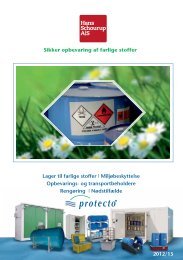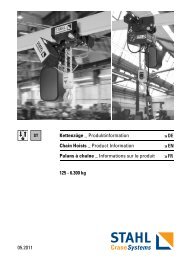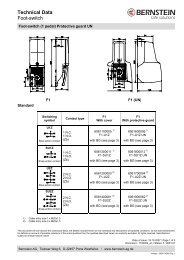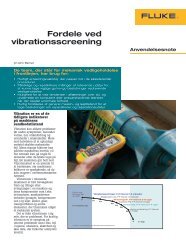Engineering plastics â The Manual - F.wood-supply.dk
Engineering plastics â The Manual - F.wood-supply.dk
Engineering plastics â The Manual - F.wood-supply.dk
You also want an ePaper? Increase the reach of your titles
YUMPU automatically turns print PDFs into web optimized ePapers that Google loves.
4. Semi-finished products made of plastic should consequently<br />
always be stored flat or on a suitable support (in the<br />
case of rods and tubes) and with the greatest possible surface<br />
contact in order to avoid deformation through their<br />
own intrinsic weight or warmth.<br />
5. When handling plastic semi-finished products, ensure<br />
that suitable warehousing equipment is used. Ensure that<br />
storage facilities, lifting gear, slings and other lifting equipment<br />
are stable and secure. Stock shapes must also be<br />
stored and stacked so as to eliminate any danger of tipping<br />
or falling. Bear in mind here that <strong>plastics</strong> often have a relatively<br />
low coefficient of friction and are consequently easily<br />
able to slip out of load suspension devices, with the possibility<br />
of serious injury to staff members.<br />
6. Avoid the effects of high-energy radiation such as gamma<br />
or X-rays wherever possible due to possible microstructure<br />
damage through molecular breakdown.<br />
7. Plastic stock shapes should be kept away from all kinds<br />
of chemicals and water in order to prevent possible chemical<br />
attack or the absorption of moisture. Contact with<br />
chemicals or water can result in swelling, chemical decomposition<br />
or stress crack formation.<br />
10. If the above recommendations are adhered to, it may be<br />
assumed that no significant changes to typical properties<br />
will occur during the storage period. It is possible that minimal<br />
surface discolouration may occur due to environmental<br />
influences. However, this does not represent any significant<br />
deterioration of material properties, as the surface is<br />
generally only affected down to a few microns in depth.<br />
11. Plastic waste and chips can be processed and recycled<br />
by professional recycling companies. It is also possible to<br />
send the waste for thermal processing to generate energy<br />
by a professional company in a combustion plant with a<br />
suitable emission control in place. This applies in particular<br />
to applications where the plastic waste produced is contaminated,<br />
e.g. in the case of machining chips contaminated<br />
with oil.<br />
<strong>The</strong>se recommendations should be adjusted expediently in<br />
line with individual requirements and circumstances.<br />
<strong>The</strong>y do not replace the fundamentally applicable statutory<br />
regulations, or exonerate customers using the products<br />
from their responsibility or individuals from their duty of<br />
care. <strong>The</strong>se are merely intended as recommendations<br />
drawn up on the basis of current knowledge. <strong>The</strong>y do not<br />
constitute any generally applicable assurance.<br />
8. Plastics are organic materials and consequently combustible.<br />
<strong>The</strong> combustion or decomposition products may<br />
have a toxic or corrosive effect. If correctly stored, <strong>plastics</strong><br />
themselves do not pose a fire risk. However, they should<br />
not be stored together with other combustible substances.<br />
On this subject, observe the product handling information<br />
sheets for the individual materials.<br />
9. Under normal conditions, plastic semi-finished or finished<br />
products do not release any toxic constituents and<br />
permit risk-free surface contact.<br />
Tobacco products should not be allowed in the vicinity<br />
when handling and machining <strong>plastics</strong>, as particles of<br />
some <strong>plastics</strong> (in particular fluoropolymers) can release<br />
strong toxic gases in some cases during pyrolization of the<br />
smouldering tobacco. In respect of health protection, please<br />
also note the product handling information sheets for the<br />
individual materials.<br />
87

















